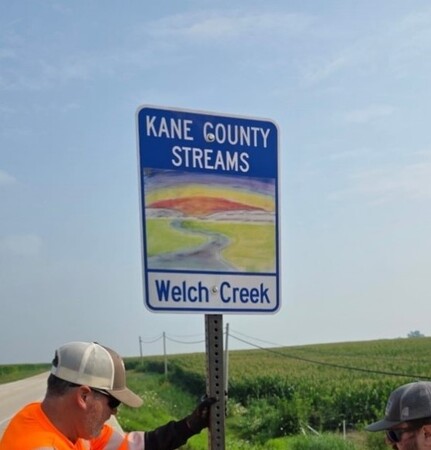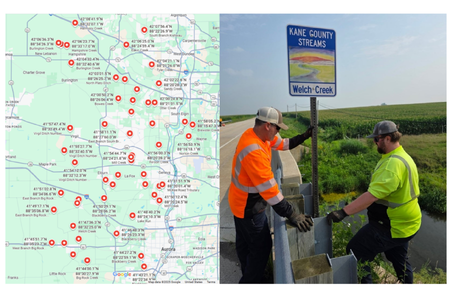
Have You Seen the New Stream Signs Around Kane County?
Kane County has installed of 106 additional stream identification signs, recognizing the beauty and importance of the county's local streams and creeks.
In 2002, Kane County Water Resources held a “Rivers Around Us” poster contest for local schools. The winning artwork was created by Jordan Lee, an 8th grader at Chicago Junior School in Elgin. Originally, over 100 signs were installed. While replacements have occurred over the years, this marks the first expansion of signage locations since the program’s launch. Residents are encouraged to look for the newly placed signs, which can be found at locations indicated on the accompanying map. 
As the county enhances its signage program to better inform residents, it is equally important to understand the vital role our local waterways play in sustaining both the water supply and environmental health. A significant portion of Kane County’s water supply comes from shallow groundwater and the Fox River. Streams are interconnected with groundwater and feed directly into the Fox River. Therefore, protecting these waterways is essential—not only for ensuring the quality of our drinking water but also for preserving our natural environment and supporting the local economy.
There are simple steps you can take to help prevent pollution runoff from reaching our streams:
Never dump anything down stormwater drains. These drains are designed for stormwater only and empty directly into streams and rivers, bypassing treatment plants.
Dispose of hazardous waste properly. To see where to dispose of or recycle items, visit Kane County’s recycling website or download the Recycle Coach app and search for Kane County and your local municipality.
Clean up after your pets. Pet waste contains bacteria and nutrients that can contaminate waterways.
Leave grass clippings on the lawn. Use a mulching mower to return nutrients to the soil and reduce the need for fertilizer.
Wash vehicles on unpaved surfaces. Washing on your lawn or other unpaved areas allows the ground to filter soapy water naturally.
Minimize pesticide and herbicide use. Consider natural alternatives or integrated management techniques, such as a rain garden paired with a rain barrel.
By implementing these simple practices, individuals can make a positive impact on the quality of local streams and rivers and contribute to a healthier environment.

